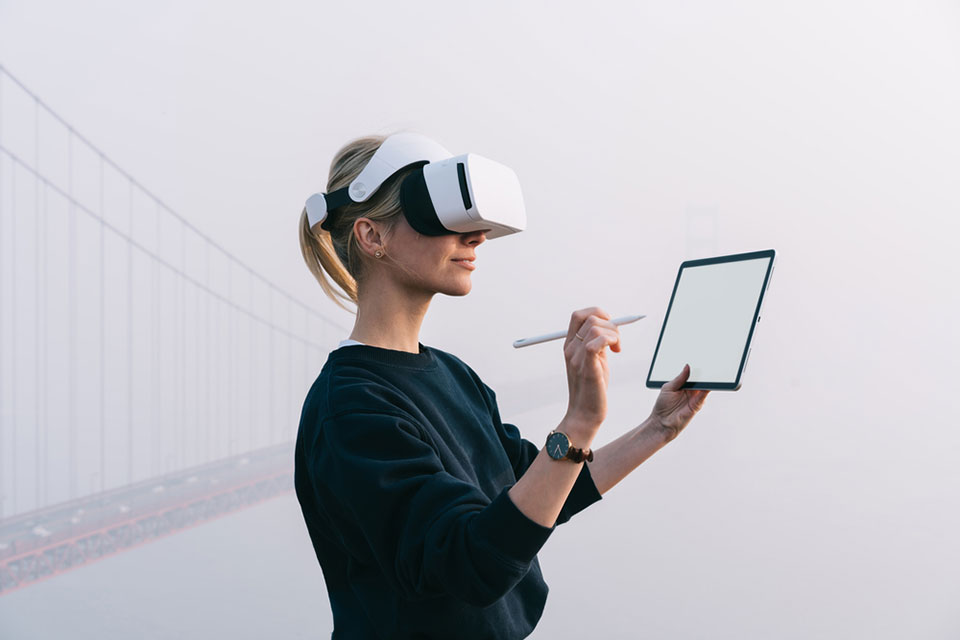3 Advantages for Big Brands Considering XR Technology

If you haven’t looked to gaming to get ideas for your business, it might just be time to start. Extended reality — also known as XR — shows incredible promise when it comes to creating business inspiration. Here are just some of the potential advantages of XR.
In the past, business leaders didn’t often look to video games and gaming in general for inspiration. That’s no longer the case, though. In fact, many of the innovations used to construct the latest games also show promise for businesses.
Consider extended reality, or XR. This technology wouldn’t be possible without the world of gaming and entertainment. After all, gaming helped make augmented and virtual reality (or AR and VR) household acronyms — and those technologies are XR’s not-so-distant cousins.
So what exactly is the function of these technologies, and how can they be leveraged in a business environment?
An Overview of Digital Reality Technology
Let’s start with AR, which involves overlaying a digital image onto something physical. Ikea leverages AR when it allows customers to see furniture in their homes through its Ikea Place app. It’s a way to “try before you buy” that virtually puts a digitized item into a real environment. And it’s been so successful that the company upgraded Ikea Place in 2021 to allow users to decorate entire rooms virtually.
VR is a bit of a different beast. Rather than enhancing the real world, it creates entirely new worlds. All you need is a special headset, and you’re transported to another land. You can see, hear, and maybe even feel what’s happening around you. Not surprisingly, some of the fastest-growing games are VR-based.
XR uses sophisticated LED screen studios set up to project images above, behind, and beneath actors. The difference between XR and a classic green screen is that as the actors move, the images move in scale and perspective. The camera and movements are seamlessly connected. Consequently, as actors who are “driving” make a left turn in a car commercial, for example, the background shifts in tandem. It’s even possible to connect the vehicle’s steering wheel to the background so it’s all done as naturally as possible.
As you might imagine, XR technology is becoming increasingly popular in commercials and the entertainment industry. It’s no wonder why Disney was one of the first companies to make full use of XR while filming the first season of “The Mandalorian.” Not only did XR allow multiple scenes of “The Mandalorian” to be shot in a single location, but the set could also be changed radically within the same day. This saves a lot of time and money, and without sacrificing quality. In fact, you would never know the series was filmed in an XR studio.
Bringing XR Into the Corporate Realm: The Challenges and Benefits
Where, then, does XR fit into the business world? Even if your brand isn’t making long-form films, you’re probably creating short-form content like commercials, video clips, or other corporate marketing assets.
With XR, you have the opportunity to produce visually engaging content for advertising, marketing, branding, and even training. As long as you have access to an XR studio that uses software such as Unreal Engine or Disguise, you’re all set.
Of course, that’s also one of the challenges when it comes to XR. There are only so many XR studios out there right now. It’s such a novel concept that more haven’t been built yet, and they’re mainly in larger cities such as Chicago or Los Angeles. With that being said, more XR studios are likely to sprout up as demand rises.
There’s another challenge to XR: It doesn’t always match the authenticity of shooting in a very specific location. Plus, if you need to perform a ton of physical activity connected to a specific background — perhaps an explosion or similarly chaotic environment — XR might not be ready to handle all the ins and outs.
At the moment, a final drawback to XR is the price. LED walls can be costly. Additionally, they take time to secure due to current supply chain issues. Yet the quality of the screens continues to go up and the price promises to level off in tandem with the national and global economy.
Due to these challenges, XR isn’t right for every corporation or video project. However, there’s no sign that the use of XR will slow down, and leveraging it could be a major differentiator for your brand. If you’re eager to try a fresh approach when it comes to your video creation, consider the advantages that can come with XR technology:
- You can slash filming costs.
If you can film an entire commercial in one LED studio, you’ve just saved a bundle on travel and setup costs. For instance, say you want to film a car commercial at a remote location. Instead of putting vehicles on semitrucks and paying to haul and store them — and also paying for all the equipment and people you need — you can get everything done in your XR studio and still get the same effect (or an even better one). - You can reduce your carbon footprint.
Are you trying to push your company in a more sustainable direction? XR can offer considerable environmental savings because you don’t have to travel all over to create a beautiful piece of content. Rather, you’re able to produce high-quality video at the same or lower costs while also lowering your carbon footprint significantly. - You can edit videos faster.
It’s a fact of filming that shots sometimes come back looking less than perfect. The sun is shining in the wrong spot. Someone didn’t notice a glaring background error. A stakeholder just doesn’t like the angle. XR technology allows you to more easily make corrections without having to reshoot anything and send a full crew back on site.
Staying on top of emerging tech trends can seem overwhelming. But don’t overlook XR — or think that it’s too complex for your brand. With the rise in the metaverse, XR is on target to be the next big thing in gaming and video creation. And it could certainly become your trick for creating video content that looks like a million bucks without costing nearly that much to produce.
Written by Bob Marsh.
Have you read?
# Best CEOs In the World Of 2022.
# Best Citizenship and Residency by Investment Programs.
# These are the world’s most and least powerful passports, 2022.
# The World’s Richest People (Top 100 Billionaires, 2022).
# Case Study: Warren Buffett, LVMH’s Bernard Arnault, Apple’s Tim Cook, and Elon Musk.
Bring the best of the CEOWORLD magazine's global journalism to audiences in the United States and around the world. - Add CEOWORLD magazine to your Google News feed.
Follow CEOWORLD magazine headlines on: Google News, LinkedIn, Twitter, and Facebook.
Copyright 2025 The CEOWORLD magazine. All rights reserved. This material (and any extract from it) must not be copied, redistributed or placed on any website, without CEOWORLD magazine' prior written consent. For media queries, please contact: info@ceoworld.biz








